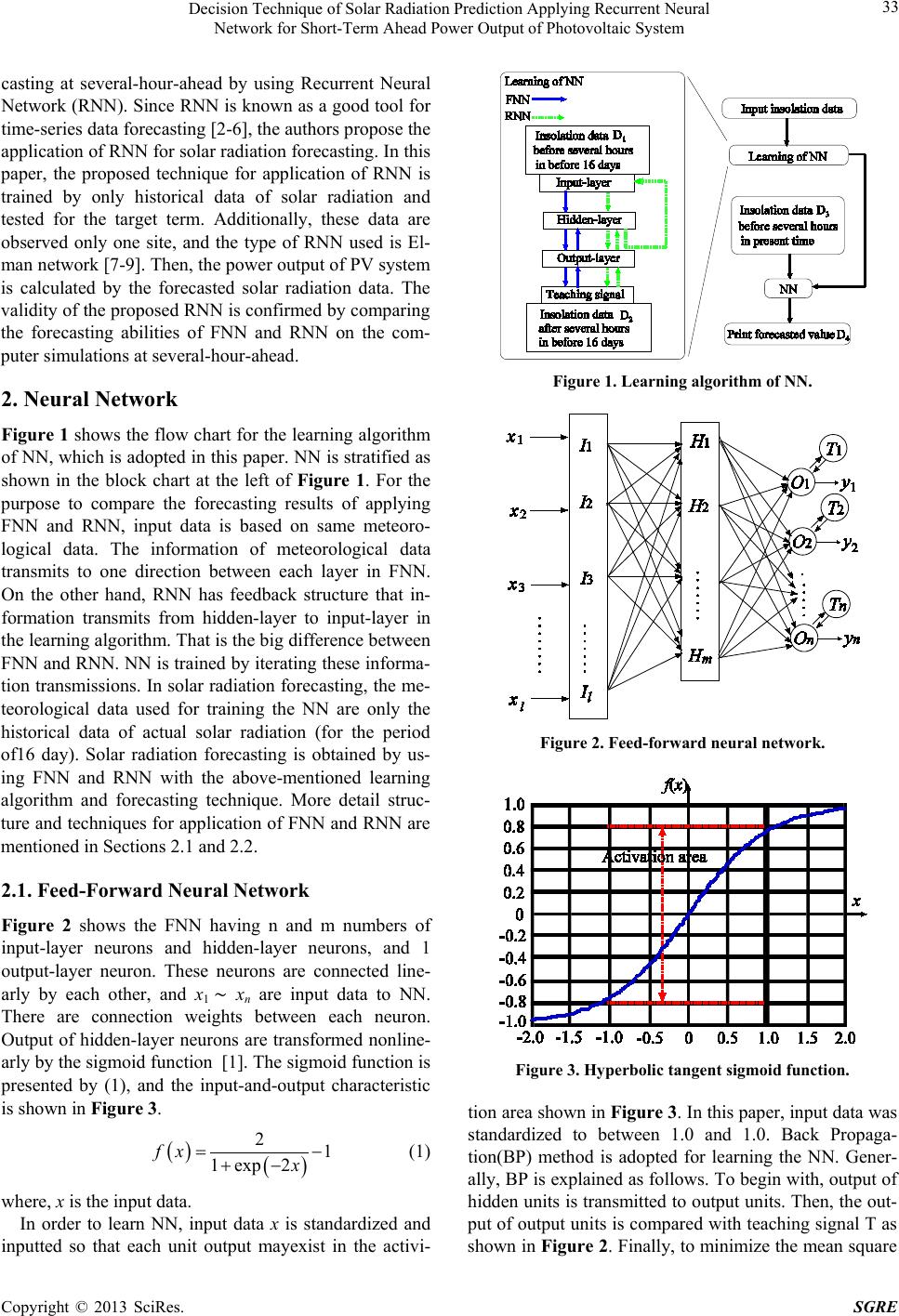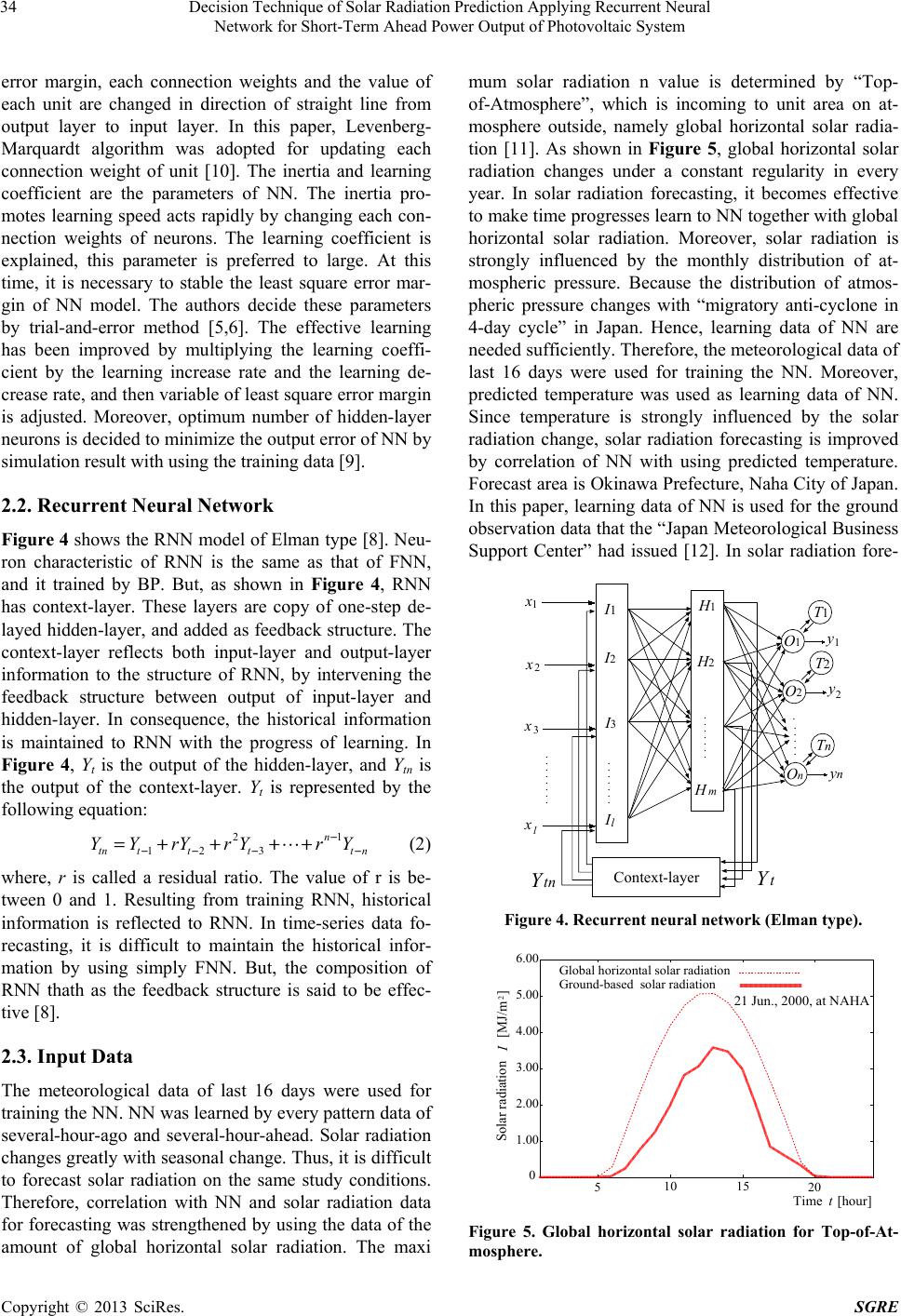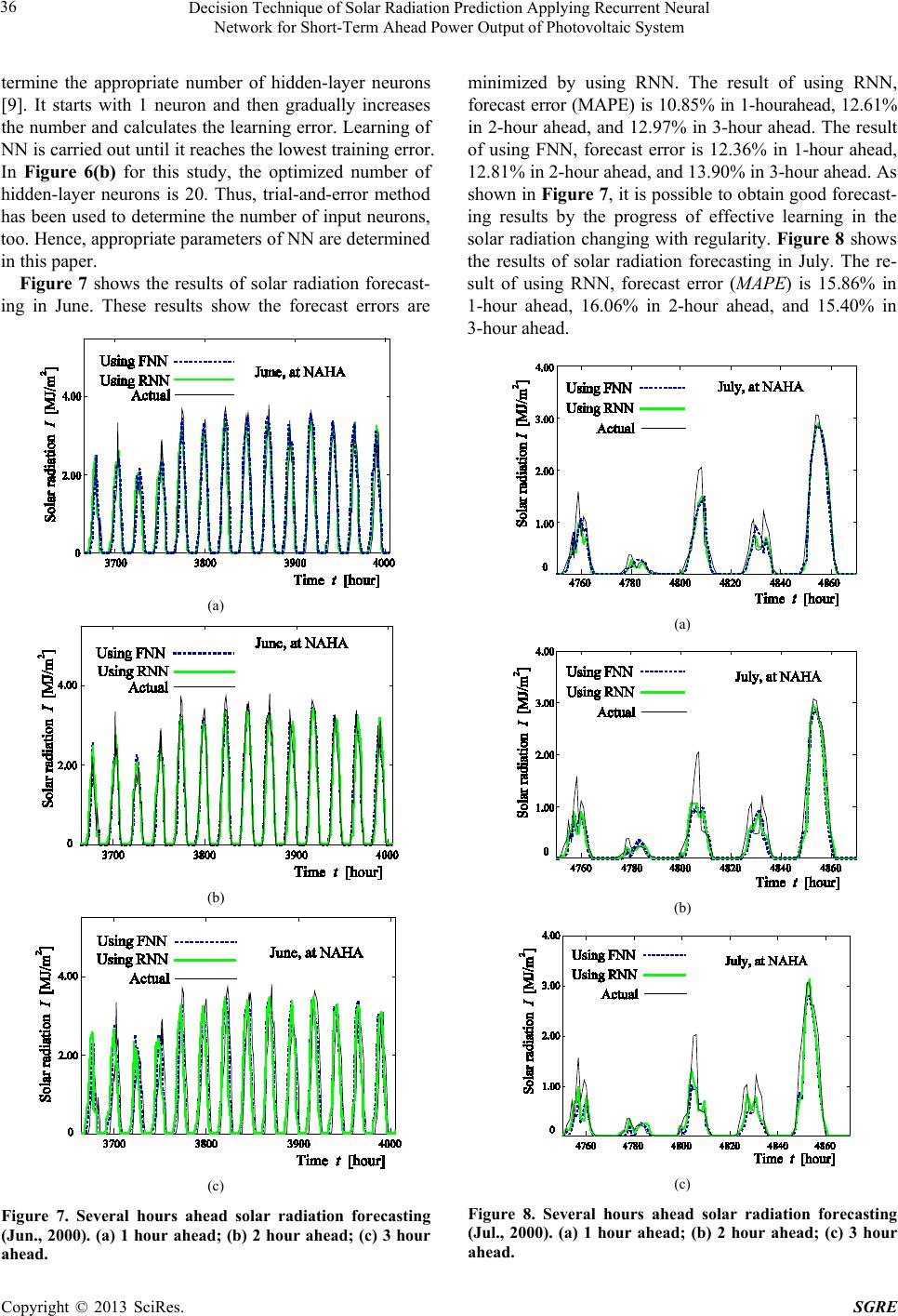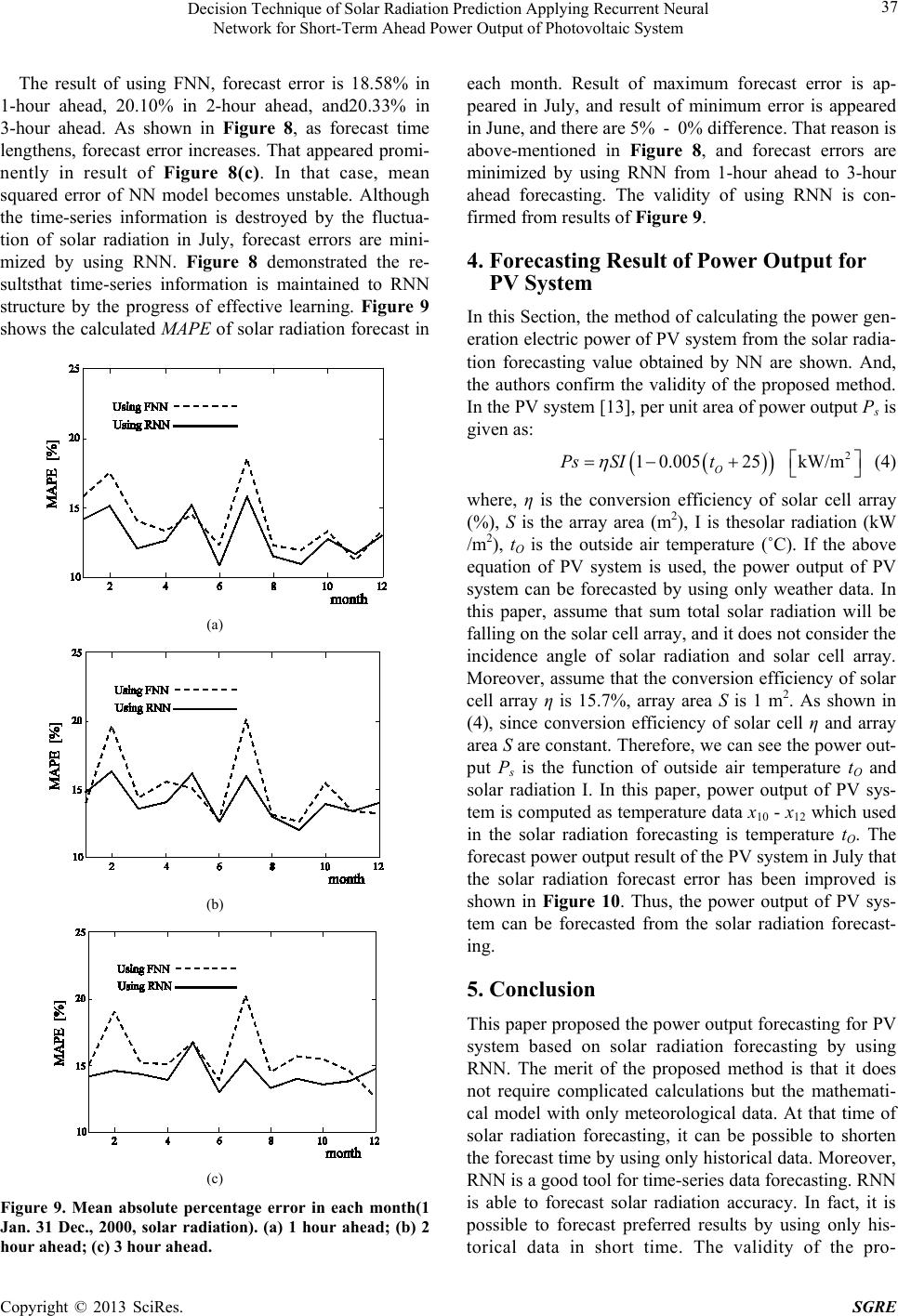 Smart Grid and Renewable Energy, 2013, 4, 32-38 http://dx.doi.org/10.4236/sgre.2013.46A004 Published Online September 2013 (http://www.scirp.org/journal/sgre) Copyright © 2013 SciRes. SGRE Decision Technique of Solar Radiation Prediction Applying Recurrent Neural Network for Short-Term Ahea d Power Output of Photovoltaic System Atsushi Yona1, Tomonobu Senjyu1, Toshihisa Funabashi2, Paras Mandal3, Chul-Hwan Kim4 1University of the Ryukyus, Okinawa, Japan; 2Meidensha Corporation, Tokyo, Japan; 3University of Texas at El Paso, El Paso, USA; 4Sungkyunkwan University, Suwon City, South Korea. Email: yona@tec.u-ryukyu.ac.jp, b985542@tec.u-ryukyu.ac.jp, funabashi-t@mb.me idensha.co.jp, pmandal@utep.edu, chkimskku@yahoo.com Received May 8th, 2013; revised June 8th, 2013; accepted June 15th, 2013 Copyright © 2013 Atsushi Yona et al. This is an open access article distributed under the Creative Commons Attribution License, which permits unrestricted use, distribution, and reproduction in any medium, provided the original work is properly cited. ABSTRACT In recent years, introduction of a re newab l e en ergy source such as solar en ergy is exp ected. However, solar radiation is not constant and power ou tput of photovoltaic (PV) system is influenced by weather conditions. It is difficult for getting to know ac curate power ou tput of PV system. In or der to forecast the p ow e r output of PV system as accurate as possible, this paper proposes a decision technique of forecasting model for short-term-ahead po wer output of PV system ba sed on solar radiation p redictio n. Ap p lication of Recurrent Neural Network (RNN) is shown for solar r adiation prediction in this paper. The proposed method in this paper does not require complicated calculation, but mathematical model with only useful weather data. The validity of the proposed RNN is confirmed by comparing simulation results of solar ra- diation forecasting with that obtained from other method Keywords: Neural Network; Short-Term-Ahead Forecasting; Power Output for PV System; Solar Ra diation Forecasting 1. Introduction Solar energy is well-known as clean energ y because of no carbon dioxide emission. Ther efore, photo-vo ltaic (PV) systems are rapidly gaining acceptance as one of the best solutions for the alternative energy source. How- ever, solar radiation is not constant and the output of PV system is influenced by solar radiation and weather con- ditions. At the point of view to improve the control per- formance of power systems, the r e should be an estima- tion of output of PV system as accurate as possible. In electric companies, solar radiation forecasting is an im- portant tool for utilizing the hybrid power systems with the storage b atter y, solar cells, wind generators, etc. For example, amount of storage battery energy is decided by forecasting data easily. These decisions are benef i t s for effective running of hybrid power systems and conse- quently their profitability depends on the forecast tech- nique. Therefore, a good solar radi ation forecas ting method is required. Although the technique to forecast the generating p o wer of PV system based on solar radia- tion forecasting is regarded as an effective method in practical applications, it requires solving differential equations by using large meteorological and topographic data. In add ition, although Meteorological Agency or weather service will pr ovide forecasting data free of charge, the implementation of above-mentioned techni- ques results in higher cost. Because, these data are fore- casting data of a wide area mostly, and are difficult for getting to know the exact value of the place in which the PV system is installed. To overcome these problems, forecasting technique should be inexpensive and easy- to-use. Application of Neural Network (NN) is known as a convenient technique for forecasting. It is possible to forecast solar radiation with only meteorological data. Most of the papers have reported application of feed- forward neural network (FNN) for solar radiation fore- casting [1-6]. However, what seems to be lacking is per- formance comparison for solar radiation forecasting of FNN and other NN. Because the forecast result of using NN is usually case-by-case with stochastic appearance of solar radiation. This paper proposes the power output forecasting of PV system based on solar radiation fore-  Decision Technique of Solar Radiation Prediction Applying Recurrent Neural Network for Short-Term Ahead Power Output of Photovoltaic System Copyright © 2013 SciRes. SGRE casting at several-hour-ahead by using Recurrent Neural Network (RNN). S ince RNN is known as a good tool for time-series data forecasting [2-6], the authors propose the application of RNN for solar r ad iation forecasting. In this paper, the proposed technique for application of RNN is trained by only historical data of solar rad iatio n and tested for the target term. Additionally, these d ata are observed only one site, and the type of RNN us ed is El- man network [7-9]. Then, the power output of PV system is calculated by the forecasted solar radiation data. The validity of the proposed RNN is confirmed by comparing the forecasting abilities of FNN and RNN on the com- puter simulations at sev eral-hour -ahead. 2. Neural Network Figure 1 shows the flow chart for the learning algorithm of NN, which is adopted in this paper. NN is stratified as shown in the block chart at the left of Figure 1. For the purpose to compare the forecasting results of applying FNN and RNN, input data is based on same meteoro- logical data. The information of meteorological da ta transmits to one direction between each layer in FNN. On the other hand, RNN has feedback structure that in- formation transmits from hidden-layer to input-layer in the learning algorithm. That is the big difference between FNN and RNN . NN is trained by iterating thes e informa- tion transmissions. In so l ar radiation forecasting, the me- teorological dat a u sed for training the NN are only the historical data of actual sola r radiation (for the p eriod of16 day). Solar radiation forecasting is obtained by us- ing FNN and RNN with the abov e-mentioned learning algorithm and forecasting technique. More detail struc- ture and techniques for application of FNN and RNN are mentioned in Sections 2.1 and 2.2. 2.1. Feed-Forward Neural Network Figure 2 shows the FNN having n and m numbers of input-layer neurons and hidden-layer neurons, and 1 output-layer neuron. These neurons are connected line- arly by each other, and x1 ∼ xn are input data to NN. There are con nection weights between each neur on. Output of hidden-layer neurons are transformed nonline- arly by the sigmoid function [1]. The sigmoid function is pre s ented by (1), and the input-and-ou tput characteristic is shown in Figure 3. (1) where, x is the input data. In order to learn NN, input data x is standardized and inputted so that each unit output mayexist in the activi- Figure 1. Learning algorithm of NN. Figure 2. Feed-forward neural network. Figure 3. Hyperbolic tangent sigmoid function. tion area shown in Figure 3. In this paper, input data was standardized to between 1.0 and 1.0. Back Propaga- tion(BP) method is adopted for learning the NN. Gener- ally, BP is explained as follows. To begin with, output of hidden units is transmitted to output units. Then, the out- put of output units is compared with teaching signal T as shown in Figure 2. Finally, to minimize the mean square  Decision Technique of Solar Radiation Prediction Applying Recurrent Neural Network for Short-Term Ahead Power Output of Photovoltaic System Copyright © 2013 SciRes. SGRE 34 error margin, each connection weights and the value of each unit are changed in direction of straight line from output layer to input layer. In this paper, Levenberg- Marquardt algorithm was adopted for updating each connection weight of unit [10]. The inertia and learning coefficient are the parameters of NN. The inertia pro- motes learning speed acts rapidly by changing each con- nection weights of neurons. The learning coefficient is explained, this parameter is preferred to large. At this time, it is necessary to stable the least square error mar- gin of NN model. The authors decide these parameters by trial-and-error method [5,6]. The effective learning has been improved by multiplying the learning coeffi- cient by the learning increase rate and the learning de- crease rate, and then variable of least square error margin is adjusted. Moreover, optimum number of hidden-layer neurons is decided to minimize the output error of NN by simulation result with using the training data [9]. 2.2. Recurrent Neural Network Figure 4 shows the RNN model of Elman type [8]. Neu- ron characteristic of RNN is the same as that of FNN, and it trained by BP. But, as shown in Figure 4, RNN has context-layer. These layers are copy of one-step de- layed hidden-layer, and added as feedback structure. The context-layer reflects both input-layer and output-layer information to the structure of RNN, by intervening the feedback structure between output of input-layer and hidden-layer. In consequence, the historical information is maintained to RNN with the progress of learning. In Figure 4, Yt is the output of the hidden-layer, and Ytn is the output of the context-layer. Yt is represented by the following equation: 21 12 3n tntttt n YY rYrYrY − −− −− =+ +++ (2) where, r is called a residual ratio. The value of r is be- tween 0 and 1. Resulting from training RNN, historical information is reflected to RNN. In time-series data fo- recasting, it is difficult to maintain the historical infor- mation by using simply FNN. But, the composition of RNN thath as the feedback structure is said to be effec- tive [8]. 2.3. Input Data The meteorological data of last 16 days were used for training the NN. NN was learned by every pattern data of several-hour-ago and several-hour-ahead. Solar radiation changes greatly with seasonal change. Thu s, it is difficult to forecast solar radiation on the same study conditions. Therefore, correlation with NN and solar radiation data for forecasting was strengthened by using the data of the amount of global horizontal solar radiation. The maxi mum solar radiation n value is determined by “Top- of-Atmosphere”, which is incoming to unit area on at- mosphere outside, namely global horizontal solar radia- tion [11]. As shown in Figure 5, global horizontal solar radiation changes under a constant regularity in every year. In solar radiation forecasting, it becomes effective to make time progresses learn to NN together with global horizontal solar radiation. Moreover, solar radiation is strongly influenced by the monthly distribution of at- mospheric pressure. Because the distribution of atmos- pheric pressure changes with “migratory anti-cyclone in 4-day cycle” in Japan. Hence, learning data of NN are needed sufficien tly. Therefo re, th e meteoro logical d ata of last 16 days were used for training the NN. Moreover, predicted temperature was used as learning data of NN. Since temperature is strongly influenced by the solar radiation change, solar radiation forecasting is improved by correlation of NN with using predicted temperature. Forecast area is Okinawa Prefecture, Naha City of Japan. In this paper, learning data of NN is used for the ground observation data that the “Japan Meteorological Business Support Center” had issued [12]. In solar radiation fore- Context-layer tn Y t Y H 1 H 2 x 2 x 3 x 1 x l . . . . . . H m . . . . . . . . . I 1 I 2 I l I 3 . . . . . . . O 1 T 1 O 2 T 2 O n y n T n .. . . . . y y 1 2 Figure 4. Recurrent neural network (Elman type). 0 1.00 2.00 3.00 4.00 5.00 6.00 51015 20 21 Jun., 2000, at NAHA Time t [hour] Solar radiation I [MJ/m ] 2 Global horizontal solar radiation Ground-based solar radiation Figure 5. Global horizontal solar radiation for Top-of-At- mosphere.  Decision Technique of Solar Radiation Prediction Applying Recurrent Neural Network for Short-Term Ahead Power Output of Photovoltaic System Copyright © 2013 SciRes. SGRE casting, input data x1 - x12 as shown in Figures 2 and 3, x1 - x3 is (solar r adiatio n data of 3 hour before)-(1 hour before), x4 - x6 is (atmospheric global solarradiation of 3 hour before)-(1 hour before), x7 - x9 is (atmospheric pressure of 3 hour before) - (1hour bef ore), x10 - x12 is (temperature of 3 hour before)-(1 hour before), and teaching signal T1 - T3 is (solar radiation data of 3 hour after)-(1 hour after). These data of NN are shown in Ta- ble 1. At forecasting time, since the forecast results are obtained by only x1 - x12 to NN as input data, teaching signal T1 - T3 are not needed. But, predicted temperatures x10 - x12 are needed for input of NN. Although predicted temperature could predict by c hanging teaching signal Tinto temperature, in this paper, predicted temperature inputted actual data. Because of that is to compare the forecasting results by us in g the historical da ta which made x10 - x12 (temperature of 3 hour before) - (1 hour before). Calculation results of the forecasted error from solar radiation forecasting in each month are shown in Section 4. 3. Solar Radiation Forecasting Result by Using FNN and RNN Table 2 shows the parameters in learning of NN, each parameter is fixed. The calculation time was 20 - 30 seconds. The learning of NN was simulated with CPU-Intel(R)-Celeron(R)-2.7GHz computer. This Sec- tion shows the simulation results of solar radiation fore- casting and calcul a t ed Mean Absolute Percentage Er- ror(MAPE) for the forecasted error by using FNN and Table 1. Input data. x1 - x3 Solar radiation at 2 hour ago-present time x4 - x6 Atmospheric global solar radiationat 2 hour ago-present time x7 - x9 Atmospheric pressure at 2 hour ago-present time x10 - x12 T emperature at 1 hour ahead-3 hour ahead Teaching signal T1 - T3 Solar radiation at 1 hour ahead-3 hour ahead Table 2. Learning parameters of NN. Number of input layer neuron 12 Number of hidden layer neuron 20 Number of output layer neuron 3 Learning coefficient 0.01 Inertia coefficient 0.25 Learning time 800 RNN in each month. MAPE is represen t e d by: [ ] 1 100 % ii Nfa i ia PP MAPE NP = − =∑ (3) where, N is the number of data, Pf is the forecast value, Pa is the actual value, and i is the number of forecasting days. Figure 6(a) is the resul t of using only the historical data in solar radiation forecasting. Figure 6(b) is there sult of using predicted temperature. As shown in Figure 6, that a forecast error was decreased by using predicted temperature. In this paper, to compare the forecast per- formance of FNN and RNN by simulation, each parame- ters of NN, e.g., number of neurons, learning coe fficient, and input data are limited. However, the number of hidden-layer neurons is de- cided to minimize the output error of NN by simulation result with using the training da ta. There are some meth- ods for obtaining the number of hidden-layer neurons; however, there is no general solution for this problem. In this paper, a trial-and-error method has been used to de- (a) (b) Figure 6. Forecast error to number of hidden-neurons. (a) Using past data of temperature; (b) Using forecasted data of temperature.  Decision Technique of Solar Radiation Prediction Applying Recurrent Neural Network for Short-Term Ahead Power Output of Photovoltaic System Copyright © 2013 SciRes. SGRE termine the appropriate number of hidden-layer neurons [9]. It starts with 1 neuron and the n gradually incr eases the number and calculates the learning error. Learning of NN is carried out until it reaches the lowest tr ain ing error. In Figure 6(b) for this study, th e op timized number of hidden-layer neurons is 20. Thus, trial-and-error method has been used to d etermine the number of input neurons, too. Hence, appropriate parameters of NN are determined in this paper. Figure 7 shows the results of solar radiation forecast- ing in June. These results show th e forecast errors are (a) (b) (c) Figure 7. Several hours ahead solar radiation forecasting (Jun., 2000). (a) 1 hour ahead; (b) 2 hour ahead; (c) 3 hour ahead. minimize d by using RNN. The result of using RNN, forecast error (MAPE) is 10.85% in 1-hourahead, 12.61% in 2-hour ahead, and 12.97% in 3-hour ahead. The result of using FNN, forecast error is 12.36% in 1-hour ahead, 12.81% in 2-hour ahead, and 1 3. 90% in 3-ho ur ahead. As shown in Figu re 7, it is possible to o b tain go od forecast- ing results by the progress of effective learning in the solar radiation changing with regularity. Figure 8 shows the results of solar radiation forecasting in July. The re- sult of using RNN, forecast error (MAPE) is 15.86% in 1-hour ahe ad, 16.06% in 2-hour ahead, and 15.40% in 3-hour ahead. (a) (b) (c) Figure 8. Several hours ahead solar radiation forecasting (Jul., 2000). (a) 1 hour ahead; (b) 2 hour ahead; (c) 3 hour ahead.  Decision Technique of Solar Radiation Prediction Applying Recurrent Neural Network for Short-Term Ahead Power Output of Photovoltaic System Copyright © 2013 SciRes. SGRE The result of using FNN, forecast error is 18.58% in 1-hour ahead, 20.10% in 2-hour ahead, and20.33% in 3-hour ahead. As shown in Figure 8, as forecast time lengthens, forecast error increases. That appeared promi- nently in resul t of Figu re 8( c). In th at case, mean squa red error of NN model becomes unstable. Although the time-series information is destroyed by the fluctua- tion of solar radiation in Ju ly , forecast errors are mini- mized by using RNN. Figure 8 demonstrated the re- sultsthat time-series information is maintained to RNN structure by the progress of effective learning. Figure 9 shows the calculated MAPE of solar rad iatio n for ecast in (a) (b) (c) Figure 9. Mean absolute percentage error in each month(1 Jan. 31 Dec., 2000, solar radiation). (a) 1 hour ahead; (b) 2 hour ahead; (c ) 3 hour ahead. each month. Result of maximum forecast error is ap- peared in July, and result of minimum error is appeared in June, and there are 5% - 0% difference. That reason is above-mentioned in Fig ure 8, and forecast erro rs are minimize d by using RNN from 1-hour ahead to 3-hour ahead forecasting. The validity of using RNN is con- firmed from results of Figure 9. 4. Forecasting Result of Power Output for PV System In this Section, the method of calculating the power gen- eration electric power of PV system from the solar radia- tion forecasting value obtained by NN are shown. And, the authors confirm the validity of the proposed method. In the PV system [13], per unit area of power output Ps is given as: ( ) ( ) 2 10.00525 kW/m O Ps SIt η =−+ (4) where, η is the conversion efficiency of solar cell array (%), S is the array area (m2), I is thesolar radiation (kW /m2), tO is the outside air temperature (˚C). If the above equation of PV system is used, the power outpu t of PV system can be forecasted by using only weather data. In this paper, assume that sum total solar r adiation w ill be falling on the solar cell array, and it does not consider the incidence angle of solar radiation and solar cell array. Moreover, assume that the conversion efficie ncy of solar cell array η is 15.7%, array are a S is 1 m2. As shown in (4), since conversion efficiency of solar cell η and array area S are constant. There f ore, we can see the power out- put Ps is the function of outsid e air temperature tO and solar radiation I. In this paper, power output of PV sys- tem is computed as temperature data x10 - x12 which used in the solar radiation forecasting is temperature tO. The forecast pow er output result of the PV system in July that the solar radiation forecast error has been improved is shown in Figur e 10. Thus, the p ower output of PV sys- tem can be forecasted from the solar radiation forecast- ing. 5. Conclusion This paper proposed the power outpu t f orecastin g for PV system ba sed on solar rad iat io n fo r ecas ti ng by using RNN. The merit of the proposed method is that it does not require complicated calculations but the mathemati- cal model with only meteorological data. At that time of solar radiation forecasting, it can be possible to shorten the forecast time by using only historical data. Moreover, RNN is a good tool for time-series data forecasting. RNN is able to forecast solar radiation accuracy. In fact, it is possible to forecast preferred results by using only his- torical data in short time. The validity of the pro-  Decision Technique of Solar Radiation Prediction Applying Recurrent Neural Network for Short-Term Ahead Power Output of Photovoltaic System Copyright © 2013 SciRes. SGRE (a) (b) (c) Figure 10. Forecast results of several hour ahead power output for PV system (Jul., 2000). (a) 1 hour ahead; (b) 2 hour ahead; (c ) 3 hour ahead. posed RNN is confirmed by comparing forecasting re- sults with that obtained from FNN. It is found that fore- cast errors are greatly minimized by RNN. Hence, the proposed RNN shows a good performance to forecast power output of PV system. REFERENCES [1] P. D. Wasserman, “Neural Computing: Theory and Prac- tice,” Van Nostrand Reinhold, New York, 1989. doi:10.1016/0893-6080(90)90059-T [2] T. Hiyama and K. Kitabayashi, “Neural Network Based Estimation of Maximum Powergeneration from PV Mod- ule Using Environmental Information,” IEEE Transaction on Energy Conversion, Vol. 12, No. 3, 1997, pp. 241-247. doi:10.1109/60.629709 [3] A. Sozen, E. Arcakhoglu, M. Ozal p and N. Caglar, “Fore- casting Based on Neural Network Approach of Solar Po- tential in Turkey,” Renewable Energy, Vol . 30, No. 7, 2005, pp. 1075-1090. doi:10.1016/j.renene.2004.09.020 [4] H. K. Elminir, F. F. Areed and T. S. Elsayed, “Estimation of Solar Radiation Components Incident on Helwansite Using Neural Networks,” Solar Energy, Vol. 79, No. 3, 2005, pp. 270-279. doi:10.1016/j.solener.2004.11.006 [5] K. S. Reddy and M. Ranjan, “Solar Resource Estimation Using Artificial Neural Networks and Comparison with Other Correlation Models,” Energy Conversion and Man- agement, Vol. 44, No. 15, 2003, pp. 2519-2530. doi:10.1016/S0196-8904(03)00009-8 [6] M. Mohandes, A. Balghonaim, M. Kassas,S. Rehm an and T. O. Halawani, “Use of Functions for Estimating Monthly Solar Radiation,” Solar Energy, Vol. 68, No. 2, 2000, pp. 161-168. doi:10.1016/S0038-092X(99)00071-7 [7] Y. Kitamura and A. Matsuda, “Study on Raising Effi- ciency of Heat Accumulating Air Conditioning System Using Knowledge Precessing Techniques,” Journal of Mitsubishi Research Institute, No. 36, 2000, pp. 31-51. [8] J. F. Elman, “Finding Structure in Time,” Cognitive Sci- ence, Vol. 14, No. 2, 1990, pp. 179-211. doi:10.1016/0364-0213(90)90002-E [9] B. Kermanshahi, “Recurrent Neural Network for Fore- casting Next 10 Years Loads of Nine Japanese Utilities,” Neurocomputing, Vol. 23, No. 1-3, 1998, pp. 125-133. doi:10.1016/0364-0213(90)90002-E [10] M. T. Hagan and M. B.Menhaj, “Training Feed-Forward Networks with the Marquardt Algorithm,” IEEE Trans- actions on Neural Networks, Vol. 5, No. 6, 1994, pp. 989- 993. doi:10.1109/72.329697 [11] M. Santamouris, G. Mihalakakou, B. Psiloglou, G. Eftax- ias and D. N. Asimakopoulos, “Modeling the Global So- lar Radiation on the Earth’s Surface Using Atmospheric Deterministic and Intelligent Data-Driven Techniques,” American Meteorological Society, Vol. 12, No. 10, 1999, pp. 179-211. [12] AmdView(C) Weather Toy, “Meteorological Data Base: Ground Observation Ver. 1.00,” Japan Meteorological Business Support Center, Tokyo, 2004. [13] A. Iga and Y. Ishihara, “Character istics and Embodiment of the Practical Use Method of ‘Monthly Temperature Coefficient’ of the Photovoltaic Generat ion System,” IEEE Japan Transactions on Power and Energy, Vol. 126, No. 8, 2006, pp. 767-775.
|